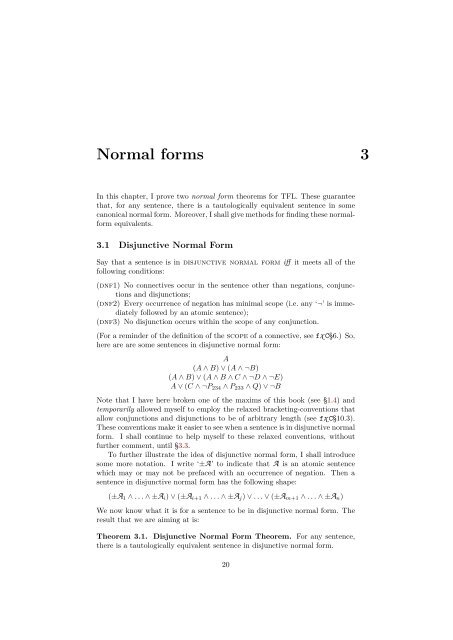Metatheory - University of Cambridge
Metatheory - University of Cambridge
Metatheory - University of Cambridge
Create successful ePaper yourself
Turn your PDF publications into a flip-book with our unique Google optimized e-Paper software.
Normal forms 3<br />
In this chapter, I prove two normal form theorems for TFL. These guarantee<br />
that, for any sentence, there is a tautologically equivalent sentence in some<br />
canonical normal form. Moreover, I shall give methods for finding these normalform<br />
equivalents.<br />
3.1 Disjunctive Normal Form<br />
Say that a sentence is in disjunctive normal form iff it meets all <strong>of</strong> the<br />
following conditions:<br />
(dnf1) No connectives occur in the sentence other than negations, conjunctions<br />
and disjunctions;<br />
(dnf2) Every occurrence <strong>of</strong> negation has minimal scope (i.e. any ‘¬’ is immediately<br />
followed by an atomic sentence);<br />
(dnf3) No disjunction occurs within the scope <strong>of</strong> any conjunction.<br />
(For a reminder <strong>of</strong> the definition <strong>of</strong> the scope <strong>of</strong> a connective, see fx C§6.) So,<br />
here are are some sentences in disjunctive normal form:<br />
A<br />
(A ∧ B) ∨ (A ∧ ¬B)<br />
(A ∧ B) ∨ (A ∧ B ∧ C ∧ ¬D ∧ ¬E)<br />
A ∨ (C ∧ ¬P 234 ∧ P 233 ∧ Q) ∨ ¬B<br />
Note that I have here broken one <strong>of</strong> the maxims <strong>of</strong> this book (see §1.4) and<br />
temporarily allowed myself to employ the relaxed bracketing-conventions that<br />
allow conjunctions and disjunctions to be <strong>of</strong> arbitrary length (see fx C§10.3).<br />
These conventions make it easier to see when a sentence is in disjunctive normal<br />
form. I shall continue to help myself to these relaxed conventions, without<br />
further comment, until §3.3.<br />
To further illustrate the idea <strong>of</strong> disjunctive normal form, I shall introduce<br />
some more notation. I write ‘±A’ to indicate that A is an atomic sentence<br />
which may or may not be prefaced with an occurrence <strong>of</strong> negation. Then a<br />
sentence in disjunctive normal form has the following shape:<br />
(±A 1 ∧ . . . ∧ ±A i ) ∨ (±A i+1 ∧ . . . ∧ ±A j ) ∨ . . . ∨ (±A m+1 ∧ . . . ∧ ±A n )<br />
We now know what it is for a sentence to be in disjunctive normal form. The<br />
result that we are aiming at is:<br />
Theorem 3.1. Disjunctive Normal Form Theorem. For any sentence,<br />
there is a tautologically equivalent sentence in disjunctive normal form.<br />
20
















